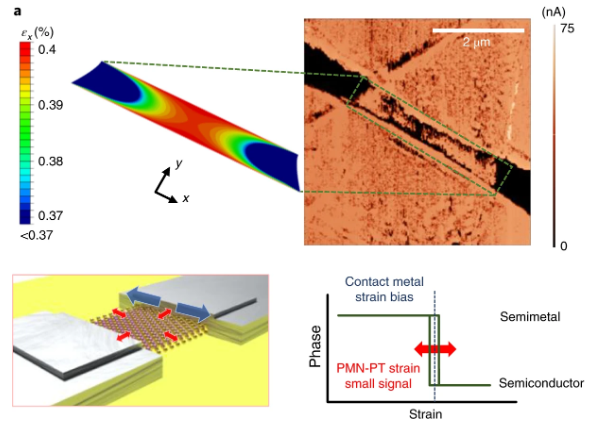Strain Engineering of 2-Dimensional Materials
Strain Engineering of 2D-bonded Materials to tune their electrical and quantum properties
 This project will use strain engineering on novel 2D phase-transition crystals to create strain-engineered devices for exploration and manipulation of Majorana bound states, toward topological quantum computing functionalities. Specifically, we study transition metal dichalcogenides such as Molybdenum Ditelluride, Molybdenum Sulfide with auxiliary elements such as Tungsten substituted in for the Molybdenum in the lattice. When subjected to strain, it is observed that the electrical properties of these materials changes and therefore, one can use strain as a means to switch these properties much like a transistor that is tunable by strain, as shown in the figure.
This project will use strain engineering on novel 2D phase-transition crystals to create strain-engineered devices for exploration and manipulation of Majorana bound states, toward topological quantum computing functionalities. Specifically, we study transition metal dichalcogenides such as Molybdenum Ditelluride, Molybdenum Sulfide with auxiliary elements such as Tungsten substituted in for the Molybdenum in the lattice. When subjected to strain, it is observed that the electrical properties of these materials changes and therefore, one can use strain as a means to switch these properties much like a transistor that is tunable by strain, as shown in the figure.
Through our collaboration with Professor Stephen Wu at the department of Electrical engineering, it is hinted through our preliminary results that the response to thin film strain in 2D-bonded materials is different than in their 3D-bonded counterparts. Knowing the exact nature of the differences will allow for a more focused attack at measuring the response of these 2D systems to strain. When subjected to strain through interfacial coherency or thin film stress, the 2D bonded layers may exhibit a gradual relaxation of deformation through inter-layer slippage. This will cause a strain gradient through the thickness that can adversely affect phase transformation. It is also possible that residual strains accumulated at the interfaces between the 2D material and capping layer/thin film stressor cause a hysteresis behavior that ultimately deviates the state of static strain caused by the capping layer and results in instabilities in device functionality and might affect the cyclability of the device. Our goal in this project is to understand mechanical response of these 2D materials and explore how strain propagates and causes phase change in these materials. Additionally, we explore the device's response to cyclic straining and ways to improve durability of the device by hindering failure through atomic alterations of the device and layup of multilayered 3D thin film. We acknowledge financial support from the National Science Foundation for this project.
